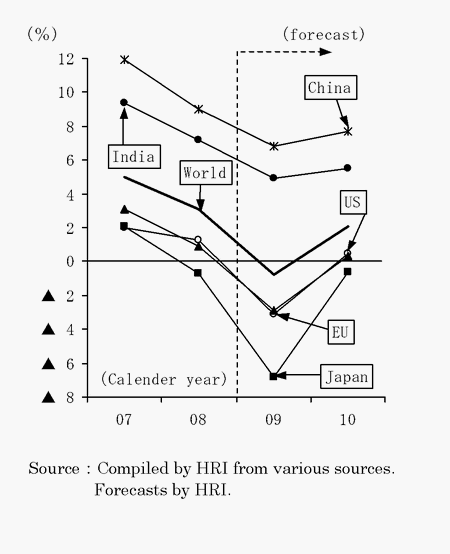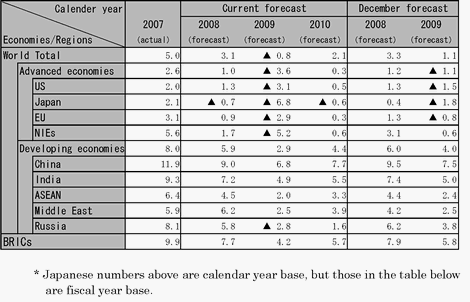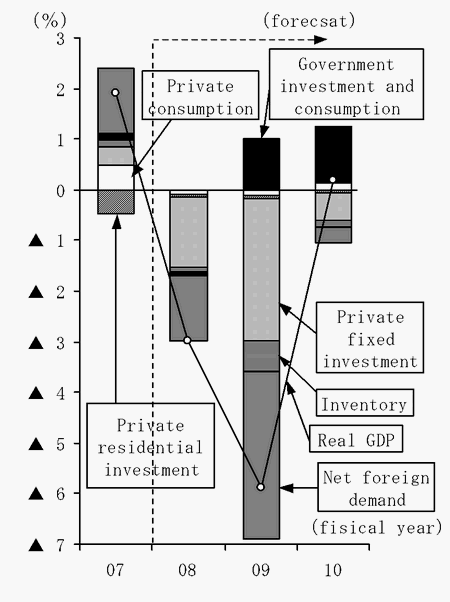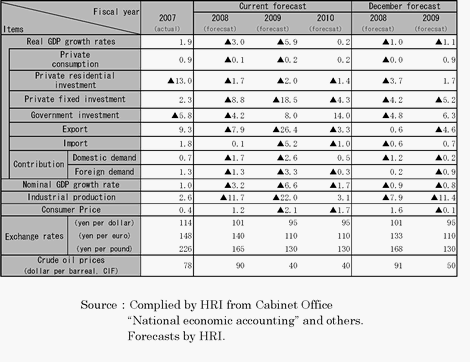Latest economic forecasts for Japan, the U.S., Europe, and China, etc
World real economy began to shrink rapidly. Annualized growth rates of real GDP in 2008 4Q were -6.2% in US , -5.8% in Euro and -12.7% in Japan. Japan and NIEs like Korea and Taiwan fell deeper than the US, the originator of the financial crisis. Every advanced country marked one of the biggest declines. The correction of US over consumption brought the severest shrinkage to exporting countries of automobiles and electronics products to the US. The inventory adjustment of these products still continues. Therefore, the decline in 2009 1Q is expected to be as bad as or even worse than 2008 4Q. The emerging countries, even China, could not escape from the negative impact. China fell into recession, though still keeps positive growth.
Fall of demand leads to decrease in production and employment. It reduces consumption. And it decreases production and employment again. This is "spiral shrinkage of the real economy". In this crisis, the shrinkage of real economy has damaged balance sheets of financial institutions and made credit crunch more severe. This is another spiral shrinkage between real economy and financial economy. The situation may not fall into Great Depression like 1930s. However, there is still possibility to fall into small depression. It is impossible to come out of both spiral shrinkages without government’s intervention.
Governments of each country announced financial stability plans and economic stimulative packages. However, so far, only the Chinese packages started to show the effects. The packages of the US is expected to pull up the demands in April. The packages of Europe and Japan will help stop downward spiral in the second half of 2009. The economic shrinkage in advanced countries would stop in the second half of 2009 at the earliest, and the economy would hit the bottom in 2010. Even if the packages bring good effects, it takes a few years for financial systems to recover to the standard level. The growth rate of world economy in 2009 will be negative, - 0.8%, for the first time since 1980 when IMF started to record the statistics. The growth rate of advanced countries in 2010 is expected to be mere 0.3%, L-shaped gradual recovery is expected. The world economy in 2010 is expected to grow by 2.1% which is less than 3% which divides good and bad times. Recession is expected to continue in 2010.
Furthermore, many risks exist in this period. The crisis in Eastern Europe countries may make financial crisis worse. US automobile makers’ bankruptcy may spread credit uncertainty. Unprecedentedly large US budget deficit may cause long term interest rates shoot up and the key currency dollar may depreciate significantly. Widespread protectionism may cause further trade shrinkage. While the standard scenario has much gloomy prospects, we need to keep the worse risk scenarios in mind.
Japanese economy fell into recession in November 2007, then started to shrink sharply in the second half of fiscal year 2008 when Lehman shock struck. Production of autos, electric machinery and general machinery decreased significantly. The production will rebound somewhat in the first half of FY 2009 when the inventories of these products are adjusted. However, production of FY 2009 is expected to be around 70% of that of FY 2007, and production facilities and labor would be very excessive. Manufacturers would be forced to face and endure 70% capacity utilization rate. We assume that additional stimulus packages of 30 trillion yen will be implemented in FY 2009 supplementary budget (the effective demand creation 3 trillion yen in FY 2009, 7 trillion yen in FY 2010) in this forecast. The real GDP growth rates are expected to be -3.0% in FY 2008, -5.9% in FY 2009 and 0.2% in FY 2010. This is the worst recession in the post-war era. The real GDP level in FY 2009 and FY 2010 is expected to be approximately 10% less than that of FY 2007. The deflation gap is large, prices fall and Japanese economy falls into deflation again. The bottom of this recession would be the second half of FY 2010. The duration of this recession will be the longest in the post-war, longer than 36 month which is recorded in the recession after the second oil shock.



